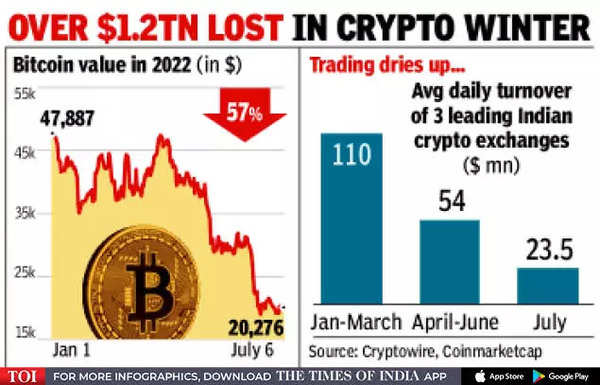Triple trouble for crypto: Liquidity crisis, bear market, new tax rules

Think about this: Between January and March this year, the average daily turnover of three of India’s leading crypto exchanges – WazirX, CoinDCX and Bitbns – was $ 110 million, data from CryptoWire knew. In the June quarter, after the first round of tax rules related to crypto trading began on April 1, this number was less than halved to 54 million dollars. And now, after the last round of rules began on July 1, requiring each buyer to pay 1% TDS for each trade, that number fell sharply again to around $ 23.5 million.

There are three reasons for this drastic drop in turnover on Indian crypto exchanges and can not be attributed to the change in tax legislation alone, said CryptoWire MD & CEO Joseph Massey.
Most central banks are on a tightening of money, which sucks liquidity out of the system. Since the pandemic hit in early 2020, central banks have pumped in outstanding amounts of money to help the economy cope with the sharp decline due to shutdowns. That was when cryptocurrencies caught the fancy of investors globally, including in India, but that tide is now turning. This has again put in a bear market for cryptocurrencies. The changes in tax legislation started just as the crypto market entered a bear phase.
With these three factors affecting the crypto industry, it is difficult to see the impact of the new taxes separately, Massey said. “Since investors here survived a long time without paying taxes, so a new tax hurts them. Historically, we have seen that taxes make an industry more organized, but with a lag. It is a period of adjustment for the crypto industry.”
Ashish Singhal, co-founder and CEO of Cryptocurrency Exchange CoinSwitch, also feels that it is a period of change for the industry. “1% TDS has certainly had an impact on trading volume across platforms in India. In India, KYC-compliant exchanges and platforms have established a framework to comply with TDS.”
Singhal also talked about another possibility: trades that change from organized crypto exchanges that comply with rules to unregulated ones, also called the ‘crypto gray market’.
The negative factors that currently plague the crypto space in India, in the long run, can also have a positive impact on the industry.
“(The silver) in this crypto harvest is that there are no government bailouts for public money,” said Khaleelulla Baig, co-founder and CEO of startup crypto investments Koinbasket. He was referring to some of the historic rescue packages provided during the 2008 financial crisis. occurs, he said.
Baig believes that all these crypto projects that fail were largely built around a weak security system, showing extensive (synthetic) products that gave unsustainably high returns.
“We may continue to see some more crypto projects built around exploitation going bankrupt and further tightening of regulations in the near future. But if we look at the long-term scenario, I see that the total market value of the crypto market crosses $ 10 trillion over the next few years. five 5 years, “said Baig. At present, cryptocurrencies have a total market value of around $ 900 billion compared to over $ 2 trillion at the beginning of the year, data from CoinMarketCap knew.

























